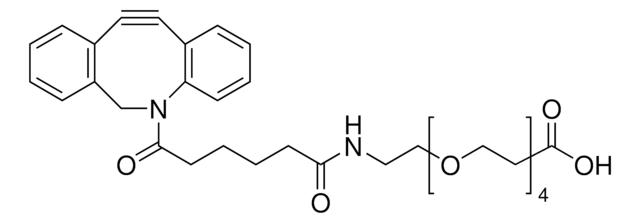761540
Dibenzocyclooctyne-amine
for Copper-free Click Chemistry
Synonym(s):
DBCO-NH2, DBCO-amine
Sign Into View Organizational & Contract Pricing
All Photos(3)
About This Item
Empirical Formula (Hill Notation):
C18H16N2O
CAS Number:
Molecular Weight:
276.33
MDL number:
UNSPSC Code:
12352116
PubChem Substance ID:
NACRES:
NA.22
Recommended Products
Assay
≥94.5 %
form
solid
reaction suitability
reaction type: click chemistry
reagent type: linker
mp
86-96 °C
functional group
amine
storage temp.
−20°C
SMILES string
NCCC(N1CC2=C(C=CC=C2)C#CC3=C1C=CC=C3)=O
InChI
1S/C18H16N2O/c19-12-11-18(21)20-13-16-7-2-1-5-14(16)9-10-15-6-3-4-8-17(15)20/h1-8H,11-13,19H2
InChI key
OCCYFTDHSHTFER-UHFFFAOYSA-N
General description
Dibenzocyclooctyne-amine (DBCO-NH2), is a heterobifunctional linker containing a DBCO moiety commonly used for the site-specific functionalization of nanobodies, enabling the addition of reactive DBCO groups for subsequent click chemistry reactions.
Application
Dibenzocyclooctyne-amine can be used as a :
- Linker to link azide-containing functional groups. It facilitates the formation of linkages through Strain-promoted azide-alkyne cycloaddition reactions (SPAAC)
- Reagent in the synthesis of N-heterocyclic carbene metal thiolates. It functionalizes the metal complexes and increases their reactivity in the strain-promoted alkyne–azide cycloaddition (SPAAC) reactions
- Amine functionalized cyclooctyne derivative. Cyclooctynes are useful in strain-promoted copper-free azide-alkyne cycloaddition reactions. This dibenzocyclooctyne will react with azide functionalized compounds or biomolecules without the need for a Cu(I) catalyst to result in a stable triazole linkage.
Storage Class Code
11 - Combustible Solids
WGK
WGK 3
Flash Point(F)
Not applicable
Flash Point(C)
Not applicable
Choose from one of the most recent versions:
Already Own This Product?
Find documentation for the products that you have recently purchased in the Document Library.
Customers Also Viewed
Steering the azido?tetrazole equilibrium of 4-azidopyrimidines via substituent variation?implications for drug design and azide?alkyne cycloadditions.
Thomann A, et al.
Organic & Biomolecular Chemistry, 13(43), 10620-10630 (2015)
Prolonging the circulatory retention of SPIONs using dextran sulfate: in vivo tracking achieved by functionalisation with near-infrared dyes.
Abdollah MR, et al.
Faraday Discussions, 175, 41-58 (2015)
Strained cyclooctyne as a molecular platform for construction of multimodal imaging probes
Sun Y, et al.
Angewandte Chemie (International Edition in English), 54(20), 5981-5984 (2015)
Catalyst-free site-specific surface modifications of nanocrystalline diamond films via microchannel cantilever spotting
Davydova M, et al.
Royal Society of Chemistry Advances, 6(63), 57820-57827 (2016)
Picomolar SARS-CoV-2 neutralization using multi-arm PEG nanobody constructs
A Moliner-Morro, et al.
Biomolecules, 10, 1661-1661 (2020)
Our team of scientists has experience in all areas of research including Life Science, Material Science, Chemical Synthesis, Chromatography, Analytical and many others.
Contact Technical Service



![(1R,8S,9s)-Bicyclo[6.1.0]non-4-yn-9-ylmethyl N-succinimidyl carbonate for Copper-free Click Chemistry](/deepweb/assets/sigmaaldrich/product/structures/969/022/d6776082-2f7a-47c7-bcd4-3830dac0fb7d/640/d6776082-2f7a-47c7-bcd4-3830dac0fb7d.png)

![(1R,8S,9s)-Bicyclo[6.1.0]non-4-yn-9-ylmethanol for Copper-free Click Chemistry](/deepweb/assets/sigmaaldrich/product/structures/171/632/0556139a-2db5-4678-a6ec-a26a693fd574/640/0556139a-2db5-4678-a6ec-a26a693fd574.png)

![N-[(1R,8S,9s)-Bicyclo[6.1.0]non-4-yn-9-ylmethyloxycarbonyl]-1,8-diamino-3,6-dioxaoctane for Copper-free Click Chemistry](/deepweb/assets/sigmaaldrich/product/structures/294/853/c5e47d84-5aee-4797-aa24-604f291171cc/640/c5e47d84-5aee-4797-aa24-604f291171cc.png)





